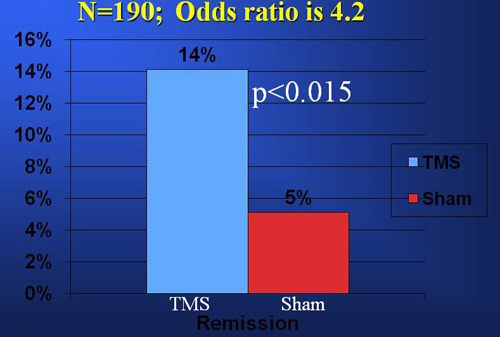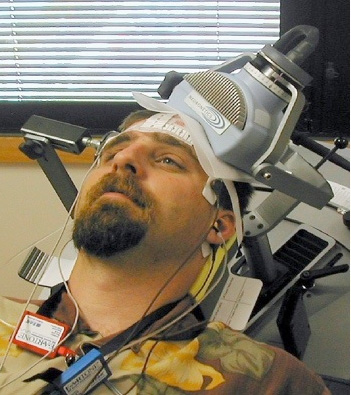Archived Content
The National Institute of Mental Health archives materials that are over 4 years old and no longer being updated. The content on this page is provided for historical reference purposes only and may not reflect current knowledge or information.
Magnetic Stimulation Scores Modest Success as Antidepressant
Trial of Non-Invasive Treatment Used New, Convincing Sham Control
• Press Release
Some depressed patients who don't respond to or tolerate antidepressant medications may benefit from a non-invasive treatment that stimulates the brain with a pulsing electromagnet, a study suggests. This first industry-independent, multi-site, randomized, tightly controlled trial of repetitive transcranial magnetic stimulation (rTMS) found that it produced significant antidepressant effects in a subgroup of patients, with few side effects.
Active rTMS treatment accounted for remissions in 14 percent of antidepressant-resistant patients actively treated, compared to about 5 percent for a simulated treatment.
"Although rTMS treatment has not yet lived up to early hopes that it might replace more invasive therapies, this study suggests that the treatment may be effective in at least some treatment-resistant patients," said Thomas R. Insel, M.D., director of the National Institute of Mental Health (NIMH), part of the National Institutes of Health, which funded the study.
Mark George, M.D., of the Medical University of South Carolina, Charleston; Harold Sackeim, Ph.D., and Sarah Lisanby, M.D., of Columbia University, New York City; David Avery, M.D., of the University of Washington, Seattle; William McDonald, M.D., of Emory University, Atlanta; and colleagues, report on their findings in the May 2010 issue of the Archives of General Psychiatry.
"This study should help settle the debate about whether rTMS works for depression," said George, who led the research team. "We can now follow up clues suggesting ways to improve its effectiveness, and hopefully further develop a potential new class of stimulation treatments for other brain disorders."
The treatment aims to jump-start underactive mood-regulating circuitry by targeting the top left front part of the brain with an electromagnetic coil that emits 3,000 pulses over a 37-minute session. It can be safely administered in a doctor's office with few side effects — unlike more invasive brain stimulation treatments, such as electroconvulsive therapy (ECT) (See Background below).
Following a decade and a half of studies yielding mixed results, the FDA cleared an rTMS device for treatment of mildly treatment resistant depression in 2008, based on data submitted by the manufacturer. The field has been awaiting the results of the NIMH-funded multi-site trial to provide more definitive evidence of efficacy.
Lack of a convincing simulation control treatment that mimics transient tapping and twitching sensations produced by the magnet weakened confidence in findings of some previous rTMS studies. To address these concerns, the new study sought to blind patients, treaters and raters with a simulation control treatment that produced the same head-tapping sensation and scalp twitching as the active treatment. A metal insert below the magnet blocked the magnetic field from entering the brain, while electrodes touching the scalp delivered the tapping sensation. This simulation was so convincing that even the treaters could not confidently guess the randomization above chance level, according to the researchers.
A sample of 190 patients who had previously failed to respond to antidepressant medications received at least three weeks of randomized, controlled magnetic stimulations on weekdays for three weeks, with the rTMS magnet aimed at their brain's left prefrontal cortex. Those who showed improvement received up to an additional three weeks of such blinded treatment.
Thirteen (14 percent) of 92 patients who received the active treatment achieved remission, compared to 5 (about 5 percent) of 98 patients who received the simulation treatment. Patients who received active rTMS were significantly more likely to reach remission, particularly if they had been moderately, rather than severely, treatment resistant. The remission rate climbed to nearly 30 percent in an open-label phase of this study in which there was no simulation control. George said this is comparable to rates seen in the STAR*D medication studies. However, the researchers note that "the overall number of remitters and responders was less than one would like with a treatment that requires daily intervention for three weeks or more, even with a benign side effect profile."
Patients who responded to active treatment received up to three weeks of additional blinded, controlled rTMS until they achieved remission or stopped showing a meaningful response – so the number of responders did not differ significantly from the number of remitters. These patients who remitted then received a combination of medications intended to help maintain the treatment effect. Despite failing to respond to medications in the past, most remained in remission for several months.
Study participants who failed to improve during the blinded phase entered a course of open-label rTMS. Among those who had been in the active rTMS group, 30 percent achieved remission during this second phase. This suggests that some patients might require as many as 5-6 weeks of daily rTMS treatment, according to George. Most patients who remitted required 3-5 weeks of treatment.
"For treatment resistant-patients, we found that rTMS is at least as good as current medications or anything else we have available, except ECT," said George. "Our current antidepressants do not work for many people."
Since the rTMS treatment did not trigger any seizures or notable side effects, the researchers propose that higher levels of magnetic stimulation be used in future studies, as evidence suggests antidepressant effects of such stimulation are dose-dependent. Higher remission rates might also be attainable if rTMS were combined with medications, they suggest.
Using magnetic resonance imaging (MRI) scans of patients' brains showing exactly where the magnetic coil was positioned, the researchers hope to confirm earlier findings suggesting that a more forward and to-the-side placement produces a larger therapeutic effect. They plan to report the results of the MRI analysis at the American Psychiatric Association meeting in late May.
Background
George, and colleagues, had earlier pioneered magnetic stimulation as a treatment for depression while at the NIMH intramural research program, beginning in the early l990s. They adapted a technology that NIH colleagues had developed for basic science studies to experimentally probe the brain. The prevailing brain stimulation therapy for treatment-resistant depression, ECT, involved a much more invasive, seizure-inducing procedure requiring general anesthesia in a surgical suite, with risk of memory loss. By contrast, rTMS could be administered to an awake, alert patient in an office setting, without a seizure or side effects — if it could be shown to work. Some skeptics argued, for example, that a seizure might be essential for a robust antidepressant effect.
In rTMS, a pulsing electromagnetic coil aimed at the brain area to be stimulated generates a magnetic field that passes readily through the skull, inducing an electrical current in the immediately adjacent brain tissue. By contrast, ECT requires a current sufficient to penetrate the skull's resistance to electricity.
Since brain imaging studies by George and colleagues found that the brain's left prefrontal cortex is under-activated in depression, their pilot rTMS studies targeted the magnet at this area, theorizing that the stimulation would likely be telegraphed to other mood-regulating areas via neural circuitry.
Following a course of such daily treatments over several weeks, some patients' mood lifted while others did not change. In the years following these early studies, dozens of small, weakly controlled studies testing rTMS for depression have continued to report varied results, so skepticism continued.
Meanwhile, neuroscience advances have led to a proliferation of clinical trials testing rTMS as a potential treatment for a variety of other conditions — from tinnitus to schizophrenia. New, invasive brain stimulation treatments for depression have also appeared — including deep brain stimulation , vagus nerve stimulation and magnetic seizure therapy . Magnetic seizure therapy is a more robust version of TMS which produces a seizure on purpose and thus requires anesthesia and a similar setting as ECT. Sobering assessments of the current crop of antidepressants' real-world effectiveness have also emerged from large-scale studies, such as STAR*D. These coincided with growing public demand for more effective, side effect-free treatments, sparking continued interest in rTMS.
Against this backdrop, the 2008 FDA clearance, or reclassification, allowed the marketing of an rTMS device for treatment of depression in mildly treatment-resistant patients, rather than for use in treatment of depression generally.
Reference
Daily left prefrontal transcranial magnetic stimulation therapy for major depressive disorder. George MS, Lisanby SH, Avery D, McDonald WM, Durkalski V, Pavlicova M, Anderson B, Nahas Z, Bulow P, Zarkowski P, Holtzheimer PD, Schwartz T, Sackeim HA. Arch Gen Psychiatry. 2010 May.

Among 190 treatment-resistant depressed patients, 14 percent of those randomly selected to receive active transcranial magnetic stimulation (TMS) achieved remission, compared to 5 percent of those who received a simulation (sham) treatment.

For the simulation rTMS treatment, electrodes on scalp delivered tapping and twitching sensations mimicking those produced by the electromagnet in the active treatment. Electrodes were attached, but inactive, in the active treatment. The patients also wore noise-dampening earphones, as demonstrated above by MUSC nurse Berry Anderson.
About the National Institute of Mental Health (NIMH): The mission of the NIMH is to transform the understanding and treatment of mental illnesses through basic and clinical research, paving the way for prevention, recovery and cure. For more information, visit the NIMH website.
About the National Institutes of Health (NIH): NIH, the nation's medical research agency, includes 27 Institutes and Centers and is a component of the U.S. Department of Health and Human Services. NIH is the primary federal agency conducting and supporting basic, clinical, and translational medical research, and is investigating the causes, treatments, and cures for both common and rare diseases. For more information about NIH and its programs, visit the NIH website .
NIH…Turning Discovery Into Health®
